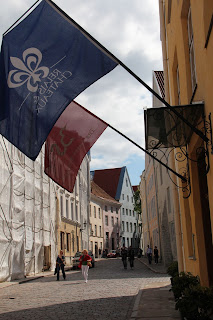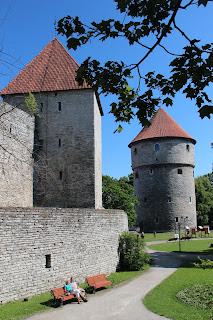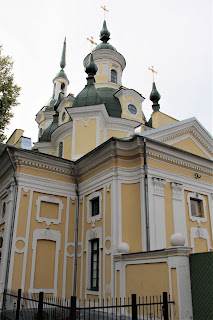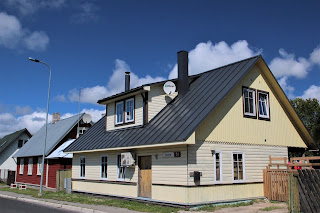A peep of the 3 Baltic states in 2011
Part 3/3
16 - Tallinn, capital of Estonia
Estonia is the smallest of the 3 Baltic states, about 2 times the size of our Perak state. The population is 1.35 million, 69% Estonians and 26% Russians. Religion wise, Protestants, Russian Orthodox and Catholics, in that order.
Tallinn, population 395,000, is the capital. In our opinion it is the most beautiful and cleanest of the 3 capital cities of the Baltic states. Shown the vibrant Town Hall Square, photos taken at ground level as well as from the tower of the Town Hall. A most beautiful city. The Old Town is a UNESCO World Heritage site.
More of the beautiful streets. The last photo shows the Church of St Olaf.
Church of the Holy Spirit
This is a small Lutheran church just off the Town Hall Square located in a congested site. It was first built in the 13th century. There is an elaborately carved clock on its façade, dated to the 17th century, Tallinn’s oldest timepiece. The interior is mostly decorated with wood panels and carvings. The 4th photo shows the main altar dated to 1483 while the pulpit, 5th photo, is dated to 1597. The modern stained glass windows are 20th century additions.
The ruins at the Dominican Monastery
The Dominican Monastery was founded in 1246, the oldest in the medieval old town. It was closed down in 1525 when the monks were expelled from Tallinn during the Protestant Reformation movement. The looted and empty monastery church was destroyed by fire in 1531 and remained a ruin.
There were originally three inner chambers in the monastery. Only the eastern chamber has been preserved to these days. Shown the ruins and some preserved reliefs and tombstones.
St Alexander Nevsky Cathedral.
This is an Orthodox church built around 1896-1900 when Estonia was part of the Russian Empire. It is in the Russian Revival style. It crowns the hill of Toompea. It was left to decline during the communist Soviet Union days but has since been restored fully after Estonia gained her independence in 1991.
Tallinn City Museum
We visited the museum located in a merchant’s house. It covers the vital aspects of the city’s past and development. Various sectors of medieval society are explained using a combination of texts, artefacts, models, etc. Shown a scaled model of a medieval house from a certain period.
The old city walls and towers
The city walls were first put up in 1265 and extended and strengthened over the centuries. Total length 1.9 km. Many sections of the old city wall are still standing and in good condition. The well preserved wall system is the main reason why the old city gets recognition as a UNESCO World Heritage site. The tower in the 1st photo is the Maiden’s Tower while that in the 2nd photo the Fat Margaret, named after Queen Margaret Sambiria who ordered the construction of the defensive wall system.
Kadriorg Palace and Park
We also visited the old Kadriorg Palace and Park developed by the Russian Tzar Peter the Great in the 1720s. The park is huge and the simple palace is now a museum.
The Kadriorg Art Museum is dedicated to early European and Russian art, pure and applied. Shown also the Poseidon sculpture at the courtyard.
Trivia
Sitting on a “broken” arch in the Margaret’s Garden where the Fat Margaret tower is located, and trying out the Segway PT personal transporter. There are city tours using such transporters, faster than walking. But we decided not to join after trying out the machine. Keeping balance on the transporter is not easy and is going to get our full attention instead of sight-seeing.
17 - Parnu, a transit point in Estonia
It is the 4th largest city in Estonia, where we changed bus (from Siauliai in Lithuania to Tallinn in Estonia). We were at the old town for 2 hours. Street scenes with old buildings.
Koidula Park
The serene park has a statue of Lydia Koidula (1843-1886), a poetess and social worker.
Churches
The Eliisabet’s Church, inaugurated in 1750 and named after a Russian queen, has a smiling face on the main door, rare for a church. It was built as an Orthodox church but is now a Lutheran. Next are facades of 2 Orthodox churches: St Catherine’s Church built in 1768 and the Lord’s Transfiguration Church completed in 1904.
18 - Haapsalu, a resort town in Estonia
Haapsalu is a seaside resort about 100 km south-west of Tallinn. It is famous for its warm seawater, mud pools and health spas. We made a day trip here to admire the beautiful farm houses in a postcard setting.
Haapsalu Castle
Haapsalu Castle was built in the 13th century, as the seat of power for the local church authorities (Bishopric of Osel-Wiek). The castle has a single-nave church as the cathedral. The religious master lost much of his influence by the end of the 16th century because of changes in politics. By the end of the 17th century most part of the castle was in ruin except the cathedral which was continued to be maintained and be used, 1st and 4th photos. The last 2 photos shows the restored internal rooms used as a museum. The scene in the last photo is enacting the alleged appearance of a white ghost on the cathedral window in August, every year.
19 - Tartu, 2nd largest city in Estonia
Tartu is the 2nd largest city in Estonia, with a population of 100,000. Shown the beautiful setting in the main Town Hall Square. The statue is called “Kissing Students”.
More of the beautiful setting, with an artist doing her part to make the city prettier. The 2nd photo shows a roof gargoyle, should you miss the full picture.

The University of Tartu
Tartu is the intellectual and cultural hub of the country. The University of Tartu, founded in 1632, is the most prestigious and largest university in the country. Part of the campus is located at Cathedral Hill where a Catholic cathedral existed since the 13th century.
It was attacked by the Protestant Reformation movement in the 1520s and gradually fell into ruins. A few preserved portals could still be seen, just beside the university museum.
On the university ground are the “seal” of Johan Skytte, the 1st chancellor, and a statue of the poet K J Peterson (1801-1922) who died of TB at the age of 21.
St John’s Church
St. John’s Church was built in the 14th century by the Catholics, last renovated in 2005. Now a Lutheran church. It is today the best-preserved monument of brick Gothic architecture in Estonia. The outstanding feature is that it originally had more than 1,000 separately modelled terracotta figurines decorating the facades of the church. About 200 survive until today and were placed in the nearby museum. Those on the niches of the church now are copies. A practice quite like placing Buddha images in niches in Buddhist temples in Asia. The figurines could be seen in the last 2 photos.
Trivia
The unusual green and fragile figure of Jaan Tonisson, a legendary statesman in the 1920s and 30s, and a round apartment building called "Tigutorn", the tallest building in town.
---------- End of Estonia and the whole tour ----------
20 - Footnote
Culture shock
Street graffiti has become some kind of culture in Europe. The Gaddafi culture is African! In Kaunas, Lithuania, we saw a piece of graffiti classed as "protected" by the city administration with a yellow plaque nailed to the wall. Our Datuk Bandar in KL or PJ will never understand that.
Means of transport within the 3 countries
Long distance bus was our main mode of transport between the cities/towns. But for a change and experience we did travel from Vilnius to Kaunas by train. About 1 hour 15 minutes for a journey of 105 km. Both places in Lithuania. We were kiasu-ly too early so the train looked empty. It was about half full on departure.
Tour within a city/town
Though we were a 4-person backpack group, GW the younger tour planner from Hong Kong was never with us come to sight-seeing in the cities. Being younger he was more interested in hiking and other outdoor adventures. He didn’t go to Siauliai even but went to stay in a seaside resort for 2 nights.
For the remaining 3 senior Malaysians, NL sometimes went on his own too. He was more interested in history and might spend hours in a museum. We 2 did join a city tour once, in Vilnius, shown with the group, 20+, a large one. These are the so-called free types, meaning there is no “official” fee collected by the guide but you are expected to tip him at the end of a tour, like 3 Euro for a 2-hour tour. We found this too fast a pace, rushing from one place to another. Very little photographing opportunity. That was the one and only city tour we joined. In other cities we just roamed around on our own helped by the more detailed city maps from the tourism offices.
Getting out of Tartu to Russia
We moved into Riga, Latvia from Russia by overnight train. And we departed Tartu, Estonia to go back to Russia by bus. This last journey was quite eventful.
The town in Russia we are going is called Pskov. But we could not find this name on the big ticketing notice board at the Tartu main bus station. Lonely Planet certainly says this is the place to board the bus. The 4th member of our group, GW, showed the relevant page of Lonely Planet to the old lady at the ticketing office. She just shrugged her shoulders and uttered some alien phases. A few minutes later a fellow German tourist came to our rescue. He told us in English the name Pskov was used only by the Russians. In Estonia, the same place is called Pikkova. Finally we bought tickets for Pikkova. And why Estonia wants to give that foreign place a different name? That region with Pskov/Pikkova as capital actually belonged to Estonia before she was “absorbed” into the Soviet Union. After Estonia gained her independence from the Soviet Union, Russia refused to return this region to Estonia.
After getting the tickets we happily took our luggage to the bus, stored the bags in the compartments provided and wanted to board. But we were stopped from boarding. The bus driver spoke to us impatiently in some alien languages. But this time the help was immediate. Other tourists told us in English that we need to buy tickets for the stored luggage. Tickets for luggage? First time we came to know. We had to go back to the ticketing office and bought more tickets. The luggage ticket cost about 20% to 30% of that for passengers.
Bad day for travel. More trouble on the way at the Estonia immigration check point. When we came into EU via Riga by train, we did not get off the train for immigration checking and passport stamping. The officers came on board the train to do the required. Unfortunately the passport of GW, our 4th member from Hong Kong, was not stamped by the Latvian officers, meaning he has no record of entry into the EU. Now we are leaving EU at the Estonia checkpoint and there was no proof he entered EU legally in the first place. The remaining 3 of us were “invited” to assist the investigation. Luckily we had a few photos with GW to prove that we were together in the trip and he entered EU via Latvia at the same time with us. It was their officers’ mistake that GW’s passport was not stamped. Many phone calls were made by the officers and we were finally let go after about 2 hours. And our long-distance bus waited there for 2 hours too. We felt so sorry for the driver and other passengers. Shown the vehicle queue at the Estonia checkpoint.
---------- End of full story ----------
(First written in the email format in August 2011. Heavily revised to this PDF format in August 2021, 10 years later)










































































